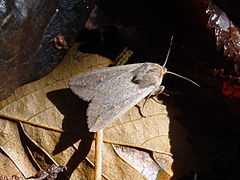Mythimna unipuncta
| Mythimna unipuncta | |
|---|---|
 | |
| Conservation status | |
| Not evaluated (IUCN 3.1) | |
| Scientific classification | |
| Kingdom: | Animalia |
| Phylum: | Arthropoda |
| Class: | Insecta |
| Order: | Lepidoptera |
| Family: | Noctuidae |
| Genus: | Mythimna |
| Species: | M. unipuncta |
| Binomial name | |
| Mythimna unipuncta (Haworth, 1809) | |
| Synonyms | |
| |
The white-speck (Mythimna unipuncta) is a moth of the family Noctuidae. It is found in North America, the Hawaiian Islands, in some areas of South America, southern Europe, North Africa, the Sahel region of Africa, Central Asia and Bangladesh to the East and East Africa.
Technical Description and variation
- See glossary for terms used
The wingspan is 41–48 mm. The length of the forewings varies from 18 to 21 mm. Forewing ochreous grey, freckled with darker grey, often suffused with rufous: markings obscure; orbicular and reniform stigmata pale or yellowish, the latter with a white dot at lower end; an outer row of dark dots on veins, joined by a dark streak from apex; hindwing fuscous grey, paler basewards, the veins dark.[1]
Biology
The white-speck is a migrant species, recorded in most months, but most frequent between August and October. .
Larvae are green to brown, freckled with darker; the lines are obscure; the dorsal is line almost lost in a dark clouding; subdorsal lines are plainer, with the upper edge diffuse; the lateral and spiracular lines are white. The larva feeds on various grasses.[2]
Larvae
The larva of Mythimna unipuncta is known as the "true armyworm" or "common armyworm" and is a major agricultural pest in North America.[3] Armyworms feed on Gramineae, which includes weedy grasses, as well as important crops such as hay, barley, corn, millet, oats, rice, rye, sorghum, sugarcane, and wheat.[4]
Outbreaks
Outbreaks of common armyworm swarms are not uncommon.[4]
In the United States, the western regions of New York experienced an outbreak of common armyworms around May 2012. While the infestation remained fairly localized, it had a significant impact on local agriculture and farming.[5] [6] Armyworms spread in great numbers to Illinois, Tennessee, Kentucky and Montana in the fall of 2012.[7]
Gallery
-

Female, dorsal view
-

Female, ventral view
-

Male, dorsal view
-

Male, ventral view
-

Caterpillar
-

Caterpillar
- ^ The flight season refers to the British Isles. This may vary in other parts of the range.
See also
- African armyworm (Spodoptera exempta) (Africa)
- Fall armyworm (Spodoptera frugiperda) (North and South America)
- Northern armyworm, oriental armyworm or rice ear-cutting caterpillar (Mythimna separata) (Asia)
References
- ↑ Seitz, A. Ed., 1914 Die Großschmetterlinge der Erde, Verlag Alfred Kernen, Stuttgart Band 3: Abt. 1, Die Großschmetterlinge des palaearktischen Faunengebietes, Die palaearktischen eulenartigen Nachtfalter, 1914
- ↑ "Robinson, G. S., P. R. Ackery, I. J. Kitching, G. W. Beccaloni & L. M. Hernández, 2010. HOSTS - A Database of the World's Lepidopteran Hostplants. Natural History Museum, London.".
- ↑ Guppy, F. Life history and behaviour of the armyworm Pseudaletia unipuncta (Haw.) (Lepidoptera: Noctuidae) in Eastern Ontario. Can. Entomol 1961. 93:1141–1153
- ↑ 4.0 4.1 John L. Capinera, University of Florida. Published October 2006. Updated May 2013 Featured Creatures: armyworm
- ↑ Charity Vogel for the Buffalo News. July 11, 2012 Armyworms coming back, but farmers can rest easy Second infestation of the destructive pest is beginning but not showing up in fields
- ↑ Geoff Palmer New York State Department of Agriculture. July 23, 2012 Pest Alert - Armyworms Round Two Hit Hay and Corn Crops
- ↑ AgTalk Forums: Armyworms in alfalfa
- (Dutch)Waring, P. en M. Townsend (2006) Nachtvlinders, veldgids met alle in Nederland en België voorkomende soorten, Baarn: Tirion.